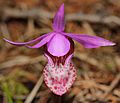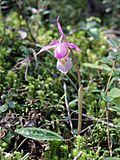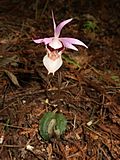Calypso bulbosa facts for kids
Quick facts for kids Calypso bulbosa |
|
|---|---|
 |
|
| Calypso bulbosa in Francis King Park, Vancouver Island, B.C., Canada | |
| Scientific classification | |
| Genus: |
Calypso
|
| Species: |
bulbosa
|
| Synonyms | |
|
|
The Calypso orchid, also known as the fairy slipper or Venus's slipper, is a beautiful flower found in cool, quiet forests. It is a type of orchid that lives for many years. This special plant gets its name, Calypso, from a Greek word meaning "to hide," because it often grows in hidden spots on the forest floor. Its other name, bulbosa, comes from its bulb-like root, called a corm.
Contents
About the Calypso Orchid
The Calypso orchid is a small plant, usually growing about 8 to 20 centimeters (3 to 8 inches) tall. It has only one leaf at its base, which is shaped like an egg. This leaf can be up to 6 centimeters long and 5 centimeters wide. The plant grows from a round, egg-shaped underground part called a tuber. This tuber helps it store food and survive the winter.
The Calypso orchid blooms with a single, colorful flower. The flower is usually purple-pink, but it can also be pink, purple, or red. It has a white "lip" (a special petal) with darker purple spots and a yellow "beard." The petals and sepals (leaf-like parts under the flower) are about 10 to 12 millimeters long. The flower's lip is shaped like a wide shoe and is about 15 to 25 millimeters long. These orchids usually bloom in May and June, after the snow melts. Each plant's underground bulb lives for no more than five years.
How Scientists Name Plants
Scientists have a system called taxonomy to name and group all living things. The Calypso orchid has 28 chromosomes, which are tiny structures inside its cells. Orchid seeds are very tiny and do not have much food stored inside them. Because of this, a Calypso orchid seed can only grow if it gets help from a special root fungus called a mycorrhiza. This fungus provides the seed with the nutrients it needs to sprout.
The Name Calypso
The name Calypso was first used for this type of orchid in 1806 by an English gardener named Richard Anthony Salisbury. Before that, in 1753, the famous scientist Carl Linnaeus had placed it in a different group of orchids called Cypripedium. However, Calypso and Cypripedium are actually very different types of orchids.
Over the years, the Calypso orchid has had a few different scientific names, but the one used today is Calypso bulbosa.
- Varieties
There are different natural types, or "varieties," of the Calypso orchid. Here are some of them:
Where Calypso Orchids Live


The Calypso orchid can be found all around the northern parts of the world. Its range includes most of Canada, the western and northern United States, Scandinavia, much of Russia, China, Mongolia, Korea, and Japan. It likes to grow in cool, shady places in northern forests and sometimes in subarctic swamps.
Even though it grows in many places, the Calypso orchid is very sensitive to changes in its environment. Because of this, it is considered threatened or endangered in several U.S. states, as well as in Sweden and Finland. It is hard to move these plants to a new spot because they rely on specific fungi in the soil to grow.
Native American peoples in North America have used the Calypso orchid's corms (underground bulbs) as a food source. The Nlaka'pamux people of British Columbia even used it as a traditional medicine.
Bumble bees help to pollinate the Calypso orchid. However, the orchid uses a trick called "pollination by deception." It attracts insects with bright colors and shapes that look like they offer nectar, but the flower actually produces no food for them. The bees quickly learn not to visit these flowers again. This trick might be why the flowers have small differences in how they look, to keep new bees coming.
See also
 In Spanish: Zapatilla de Venus para niños
In Spanish: Zapatilla de Venus para niños













